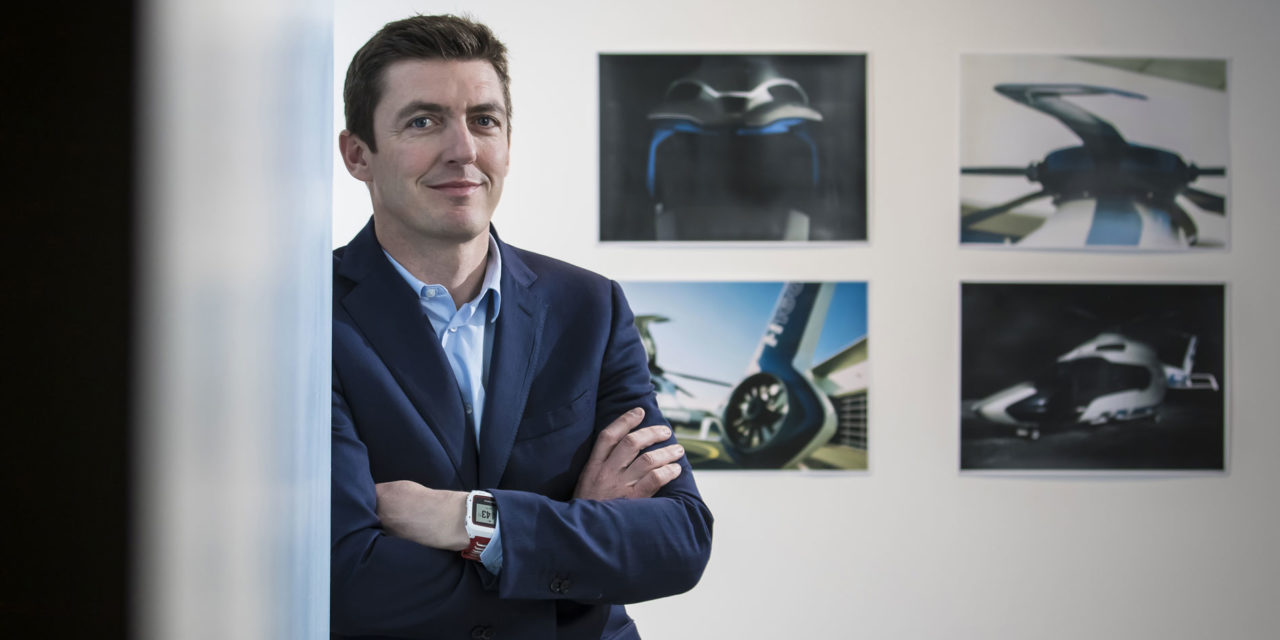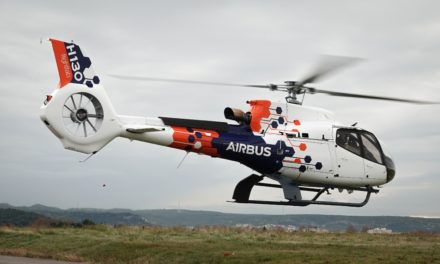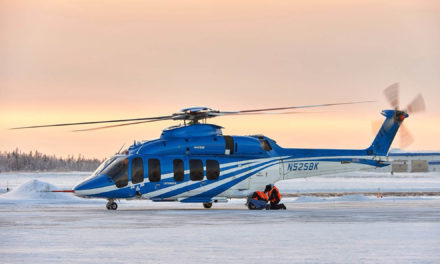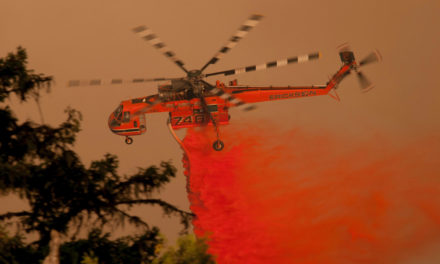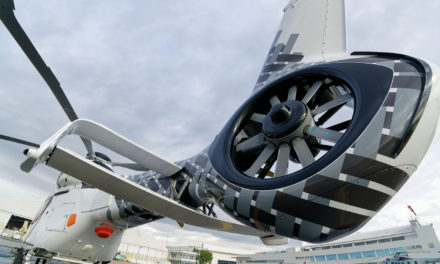After a flight test conducted by our employee Olivier Mabille, Helicopter Industry wanted to make a point on the evolution of the H160 with the deputy director of the program, Franck Dessenis.
Could you give us an overview of the progress of the program?
2018 was a very rich year for the program with a “demo tour” of more than five months in the United States with the # 2 prototype (PT2). From February to the end of July we made 75 flights for more than 200 customers, notably in Texas and New York. We have paired this demonstration program with a number of important program tests such as the Inlet Barrier Filter (IBF) test and the hot weather test at different temperatures and altitudes. This campaign was part of the certification definitions with the FAA – Federal Aviation Administration – as well as the EASA – European Aviation Safety Agency. We also took advantage of this American trip to demonstrate maintenance and accessibility to different areas of the aircraft in difficult conditions. In parallel to these tests, we worked with the PT1 and PT3 prototypes at Marignane to finalize the flight simulator flights. The program totals just over 900 flight hours, including customer demonstrations.
During this USA tour, what was the feedback from potential buyers?
The feedback from our customers is in line with what we had already seen during our demonstrations in Marignane. The main areas of satisfaction were the low cabin noise, low outside noise, cockpit visibility and system automation via the Helionix dashboard. We have shown that the H160 is a new generation aircraft not only because of its technical aspects, but also in terms of industry and machine maintenance.
Given the stated performance, have some been beyond the desired expectations?
When running a program, we always anticipate a certain number of indications. However, three points confirmed our choices which exceeded our expectations, even if it is not about exceeding pure performance, but rather getting positive feedback from customers. First, the return of the VIP market, on which we did not expect such a craze. This positive point is related in particular to the style, low cabin noise level and external noise. Our demonstrations on this point, especially in the USA, surprised many customers. The feeling of security has also been one of the good surprises in much of the feedback we’ve had and that makes a real difference compared to our direct competitors in the market, according to people who tested the aircraft. The third point will remain the sensitivity of our customers to aspects of competitiveness that have reinforced our technical choices in the aircraft. We have invested so much so that the H160 combines performance with low operational costs, which is unique in the market.
What are the main technological innovations on the H160?
With the H160, Airbus Helicopters capitalized on a technical innovation, but also on a new development logic. Regarding the technological part, we have 68 patents pending on this machine. The H160 is a condensed innovation, but it is not a technological demonstrator. We validated these innovations in advance before installing them on the program to control an aircraft whose technology is established. If I were to mention only a few technologies that stand out from what currently exists, I would mention the integration of:
- “Blue Edge” blades designed to significantly reduce noise outside the machine,
- the biplane which allows an excellent level of stabilization while allowing the reduction of the impact of the rotor on the payload,
- the fenestron inclined at 12 ° which brings all the benefits of such a system and in particular while the aircraft is rising and hovering at altitude,
- -the new Arrano 1A engine developed with Safran Helicopter Engines, which provides access to a high level of performance while reducing fuel consumption and CO2 emissions.
- a fully certified civil composite structure.
- and finally, a fully electric train to simplify maintenance.
It is important to emphasize that it is not so much the innovations themselves, but also the way which they have been developed that make the H160 a new generation helicopter. We have invested heavily in the system and the prototypes with the “Dynamic Helicopter Zero” on the ground, to test all the mechanical and engine assemblies, the “System Helicopter Zero” used as an integrated system test bench to check the proper functioning and good interactions between systems. It is on these that innovations have been validated before their implementation on the test prototype.
What are the innovations in the manufacturing of the H160?
The H160 is the first machine produced by Airbus Helicopters since the transformation and renaming of the company. Our industrial model is a reflection of this new corporate strategy. We have implemented the model Main Component Assembly – MCA – which is based on the assembly of subassemblies produced from different specialized sites: structure in Donauwörth, tail boom in Albacete and pale at Le Bourget-. This allows us to focus on the assembly line located in Marignane with a reduced number of elements to assemble, about 1,000 on the H160 against 4,000 previously on the AS365 Dauphin. We invested heavily in the assembly line and took over what existed in Toulouse to have an integrated supply chain with a total of seven stations, including two in additional configurations. At the same time, thanks to 3D, we have been able to develop a high-quality assembly process. In total, forty days of assembly are required before a machine can leave the factory.
Innovation is also present in maintenance. On this machine, which is expected to remain operational for 30 or 40 years, the support teams have worked with design teams to improve accessibility during maintenance of the aircraft on a daily basis and flexibility in the plan maintenance methodology through to the MSG-3 (Maintenance Steering Group-3) inspection methodology.
Could you give us an update on the militarized version of the H160?
An announcement was made in 2017 by the French government for a pre-selection of the H160 for the Joint Helicopter Program – HiL. For the time being, we are doing the first analysis and we are carrying out risk assessment studies. The idea is to work on the militarization of a civilian platform with all the strengths of this machine. The concept is interesting because it is a single fleet, harmonized between the different forces and able to perform a number of missions. This fleet will benefit from all synergies in terms of maintenance, configuration management, logistics, but also training. In addition to the intrinsic gains of the machine that are accessibility and lower operating costs than the previous generation, it will benefit from advances in digitization, particularly on 3D documentation for pilots and mechanics.
Besides France, are other countries interested in this version?
This range of new generation aircraft is necessarily attractive for a number of countries. Nevertheless, our priority is for the moment the preparation for the certification of the civil version and later the HiL version. We do not have any specific activity on this topic yet.
What is the market potential for the H160?
The H160 is the “Swiss Army knife”, ranging from VIP transport, oil and gas missions to evacuation and search and rescue missions, and even to the police. Its ability to achieve a broad spectrum of missions should allow us to offset the ups and downs of different markets. Besides the fact that our launch client will be Babcock, we are not communicating on our order books. But I can assure you that we are in discussion with a number of operators around the world. The positioning of competitiveness which is the strength of this aircraft, seduces many operators and we can bet on the renewal of some fleets.
Finally, when do you believe you will get the certification of the aircraft and its commissioning?
We are starting the delivery to EASA of a number of documents and test results. We believe that we will have achieved the majority of our certification files at the end of the year and all of them by mid-2019. The idea is to get the EASA and FAA certification of the aircraft in the second half of 2019 and its commissioning in the wake.

